ISPM15 国际贸易中木质包装材料管理准则
- 格式:pdf
- 大小:373.81 KB
- 文档页数:5
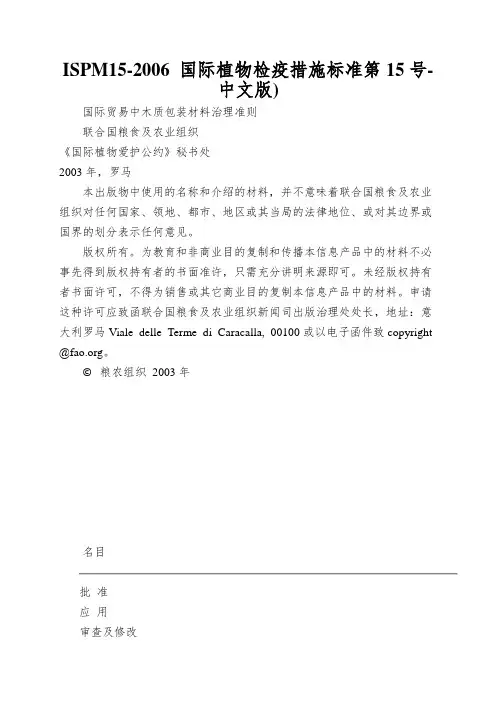
ISPM15-2006 国际植物检疫措施标准第15号-中文版)国际贸易中木质包装材料治理准则联合国粮食及农业组织《国际植物爱护公约》秘书处2003年,罗马本出版物中使用的名称和介绍的材料,并不意味着联合国粮食及农业组织对任何国家、领地、都市、地区或其当局的法律地位、或对其边界或国界的划分表示任何意见。
版权所有。
为教育和非商业目的复制和传播本信息产品中的材料不必事先得到版权持有者的书面准许,只需充分讲明来源即可。
未经版权持有者书面许可,不得为销售或其它商业目的复制本信息产品中的材料。
申请这种许可应致函联合国粮食及农业组织新闻司出版治理处处长,地址:意大利罗马Viale delle Terme di Caracalla, 00100或以电子函件致copyright @。
©粮农组织2003年名目批准应用审查及修改分发引言范围参考文献定义和缩写要求概要治理要求1. 限定的依据2. 限定木质包装材料3. 关于木质包装材料的措施3.1 批准的措施3.2 待批准的措施3.3 其它措施3.4 对措施的审查业务要求4. 垫木5. 输出之前采纳的程序5.1 关于在输出之前采纳的措施的遵守情形检查5.2 过境安排6. 输入时的程序6.1 在入境口岸违规的措施6.2 处置附件I - 有关木质包装材料的批准的措施附件II - 批准的措施的标记附件III - 本标准中正在审议供批准的措施批准国际植物检疫措施标准由《国际植物爱护公约》秘书处编纂,作为联合国粮食及农业组织全球植物检疫政策和技术援助打算的一部分。
该打算为使植物检疫措施实现国际统一而向粮农组织成员和其他有关各方提供标准、准则及建议,以期促进贸易并幸免采纳诸如贸易壁垒等无理措施。
本标准已由植物检疫措施临时委员会于2002年3月批准。
联合国粮食及农业组织总干事雅克·迪乌夫应用《国际植保公约》缔约方和非缔约方的粮农组织成员经由植检措施临时委员会通过了国际植检措施标准。
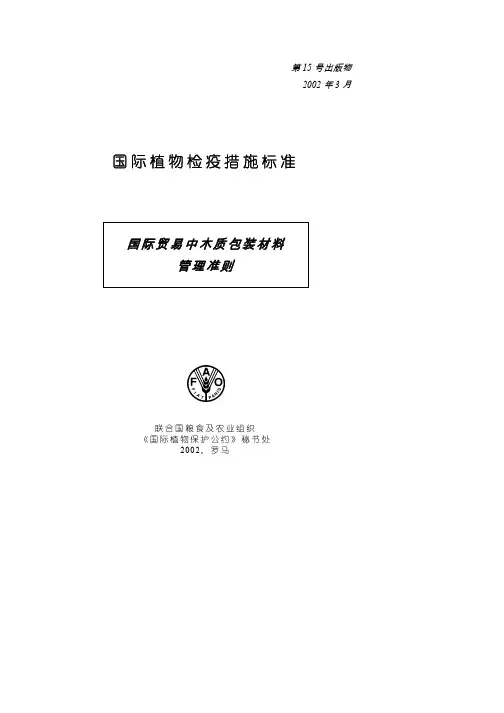

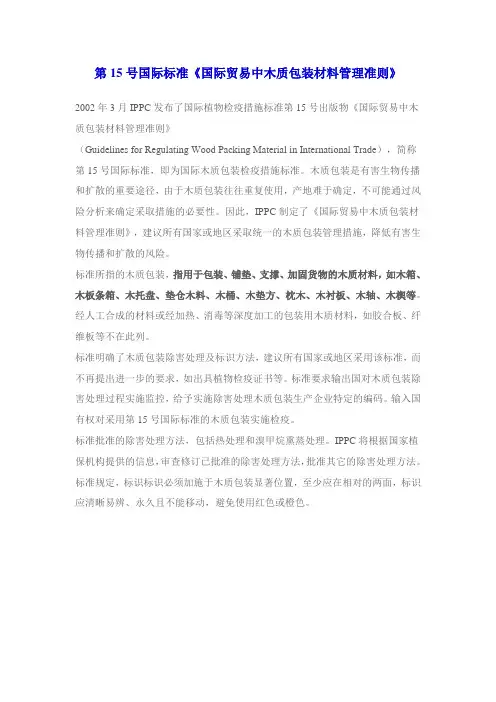
第15号国际标准《国际贸易中木质包装材料管理准则》
2002年3月IPPC发布了国际植物检疫措施标准第15号出版物《国际贸易中木质包装材料管理准则》
(Guidelines for Regulating Wood Packing Material in International Trade),简称第15号国际标准,即为国际木质包装检疫措施标准。
木质包装是有害生物传播和扩散的重要途径,由于木质包装往往重复使用,产地难于确定,不可能通过风险分析来确定采取措施的必要性。
因此,IPPC制定了《国际贸易中木质包装材料管理准则》,建议所有国家或地区采取统一的木质包装管理措施,降低有害生物传播和扩散的风险。
标准所指的木质包装,指用于包装、铺垫、支撑、加固货物的木质材料,如木箱、木板条箱、木托盘、垫仓木料、木桶、木垫方、枕木、木衬板、木轴、木楔等。
经人工合成的材料或经加热、消毒等深度加工的包装用木质材料,如胶合板、纤维板等不在此列。
标准明确了木质包装除害处理及标识方法,建议所有国家或地区采用该标准,而不再提出进一步的要求,如出具植物检疫证书等。
标准要求输出国对木质包装除害处理过程实施监控,给予实施除害处理木质包装生产企业特定的编码。
输入国有权对采用第15号国际标准的木质包装实施检疫。
标准批准的除害处理方法,包括热处理和溴甲烷熏蒸处理。
IPPC将根据国家植保机构提供的信息,审查修订已批准的除害处理方法,批准其它的除害处理方法。
标准规定,标识标识必须加施于木质包装显著位置,至少应在相对的两面,标识应清晰易辨、永久且不能移动,避免使用红色或橙色。
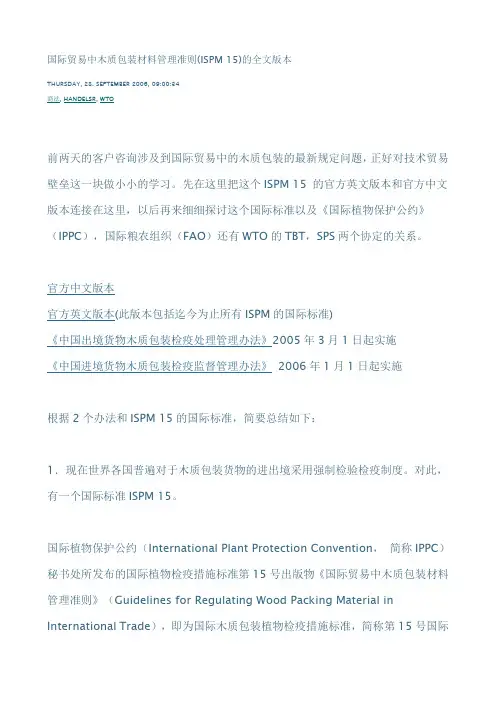
国际贸易中木质包装材料管理准则(ISPM 15)的全文版本THURSDAY, 28. SEPTEMBER 2006, 09:00:34商法, HANDELSR, WTO前两天的客户咨询涉及到国际贸易中的木质包装的最新规定问题,正好对技术贸易壁垒这一块做小小的学习。
先在这里把这个ISPM 15 的官方英文版本和官方中文版本连接在这里,以后再来细细探讨这个国际标准以及《国际植物保护公约》(IPPC),国际粮农组织(FAO)还有WTO的TBT,SPS两个协定的关系。
官方中文版本官方英文版本(此版本包括迄今为止所有ISPM的国际标准)《中国出境货物木质包装检疫处理管理办法》2005年3月1日起实施《中国进境货物木质包装检疫监督管理办法》2006年1月1日起实施根据2个办法和ISPM 15的国际标准,简要总结如下:1.现在世界各国普遍对于木质包装货物的进出境采用强制检验检疫制度。
对此,有一个国际标准ISPM 15。
国际植物保护公约(International Plant Protection Convention,简称IPPC)秘书处所发布的国际植物检疫措施标准第15号出版物《国际贸易中木质包装材料管理准则》(Guidelines for Regulating Wood Packing Material in International Trade),即为国际木质包装植物检疫措施标准,简称第15号国际植物检疫措施标准(ISPM15)。
各国都普遍采用或参照ISPM 15,制定有关国内法。
2.我国于2005年3月1日起施行《出境货物木质包装检疫处理管理办法》,于2006年1月1日起实施《入境货物木质包装检疫处理管理办法》。
至此,我国对于商品的木质包装方面已全面和国际接轨,采用最新的国际标准。
该国际标准的要求可以简述为,要求各国对于出入境的货物的木质包装,2.1 按规定进行检疫除害处理,包括热处理(以HT标记)和溴甲烷熏蒸处理(以BT标记);2.2 按规定加施专用标识;如我国的IPPC的专用标识样式如右,含义如下。
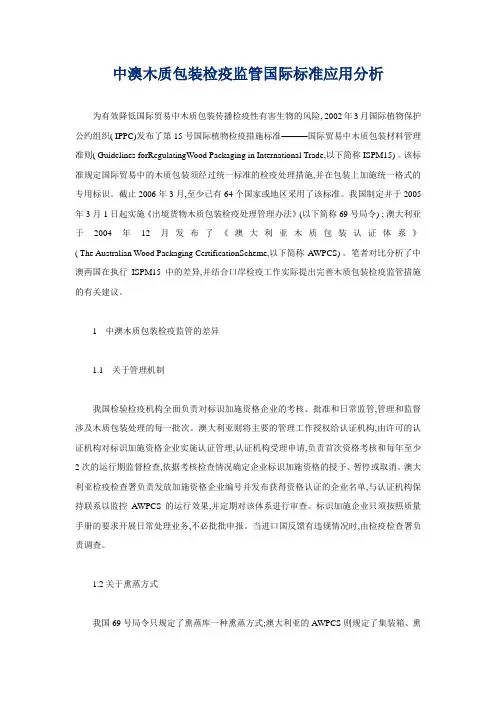
中澳木质包装检疫监管国际标准应用分析为有效降低国际贸易中木质包装传播检疫性有害生物的风险, 2002年3月国际植物保护公约组织( IPPC)发布了第15号国际植物检疫措施标准———国际贸易中木质包装材料管理准则( Guidelines forRegulatingWood Packaging in International Trade,以下简称ISPM15) 。
该标准规定国际贸易中的木质包装须经过统一标准的检疫处理措施,并在包装上加施统一格式的专用标识。
截止2006年3月,至少已有64个国家或地区采用了该标准。
我国制定并于2005年3月1日起实施《出境货物木质包装检疫处理管理办法》(以下简称69 号局令) ; 澳大利亚于2004年12月发布了《澳大利亚木质包装认证体系》( The Australian Wood Packaging CertificationScheme,以下简称AWPCS) 。
笔者对比分析了中澳两国在执行ISPM15中的差异,并结合口岸检疫工作实际提出完善木质包装检疫监管措施的有关建议。
1中澳木质包装检疫监管的差异1.1关于管理机制我国检验检疫机构全面负责对标识加施资格企业的考核、批准和日常监管,管理和监督涉及木质包装处理的每一批次。
澳大利亚则将主要的管理工作授权给认证机构,由许可的认证机构对标识加施资格企业实施认证管理,认证机构受理申请,负责首次资格考核和每年至少2次的运行期监督检查,依据考核检查情况确定企业标识加施资格的授予、暂停或取消。
澳大利亚检疫检查署负责发放加施资格企业编号并发布获得资格认证的企业名单,与认证机构保持联系以监控AWPCS的运行效果,并定期对该体系进行审查。
标识加施企业只须按照质量手册的要求开展日常处理业务,不必批批申报。
当进口国反馈有违规情况时,由检疫检查署负责调查。
1.2关于熏蒸方式我国69号局令只规定了熏蒸库一种熏蒸方式;澳大利亚的AWPCS则规定了集装箱、熏蒸库和帐幕3种熏蒸方式。
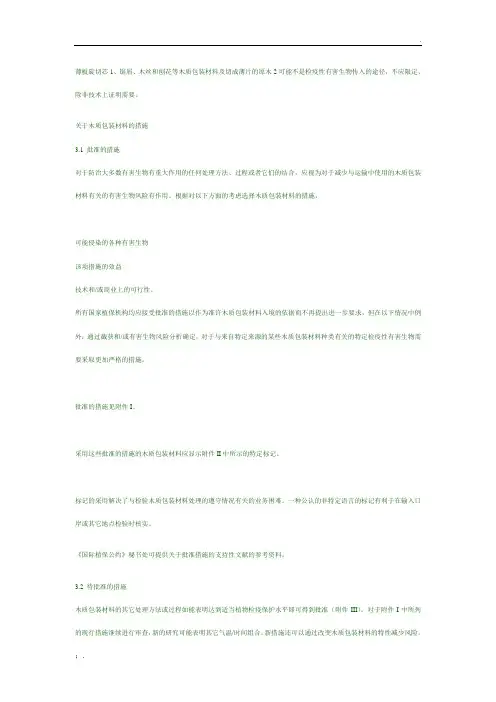
薄板旋切芯1、锯屑、木丝和刨花等木质包装材料及切成薄片的原木2可能不是检疫性有害生物传入的途径,不应限定,除非技术上证明需要。
关于木质包装材料的措施3.1 批准的措施对于防治大多数有害生物有重大作用的任何处理方法、过程或者它们的结合,应视为对于减少与运输中使用的木质包装材料有关的有害生物风险有作用。
根据对以下方面的考虑选择木质包装材料的措施:可能侵染的各种有害生物该项措施的效益技术和/或商业上的可行性。
所有国家植保机构均应接受批准的措施以作为准许木质包装材料入境的依据而不再提出进一步要求,但在以下情况中例外:通过截获和/或有害生物风险分析确定,对于与来自特定来源的某些木质包装材料种类有关的特定检疫性有害生物需要采取更加严格的措施。
批准的措施见附件I。
采用这些批准的措施的木质包装材料应显示附件II中所示的特定标记。
标记的采用解决了与检验木质包装材料处理的遵守情况有关的业务困难。
一种公认的非特定语言的标记有利于在输入口岸或其它地点检验时核实。
《国际植保公约》秘书处可提供关于批准措施的支持性文献的参考资料。
3.2 待批准的措施木质包装材料的其它处理方法或过程如能表明达到适当植物检疫保护水平即可得到批准(附件III)。
对于附件I中所列的现行措施继续进行审查,新的研究可能表明其它气温/时间组合。
新措施还可以通过改变木质包装材料的特性减少风险。
国家植保机构应认识到,措施可以增加或改变,并应有相当灵活的木质包装材料输入要求以便在得到批准之后作变动。
3.3 其它措施国家植保机构可通过与其贸易伙伴的安排,接受除附件I中所列的那些措施以外的任何措施,特别是在输入国不能采用或验证附件I中所列措施的情况下。
这种措施应在技术上证明有理由,并应遵守透明、无歧视和等同性原则。
对于与来自有证据表明有害生物风险得到适当控制或者不存在(例如植检情况相似或非疫区)的任何国家(或特定来源)的出口产品有关的木质包装材料,输入国的国家植保机构可以考虑作出其它安排。
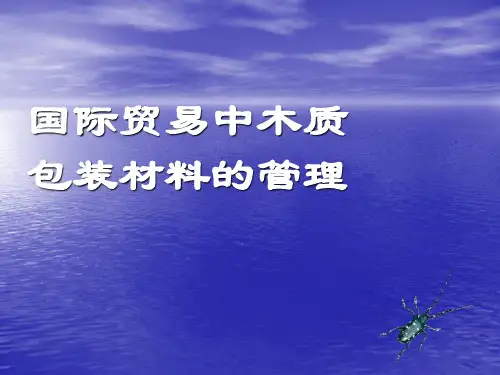
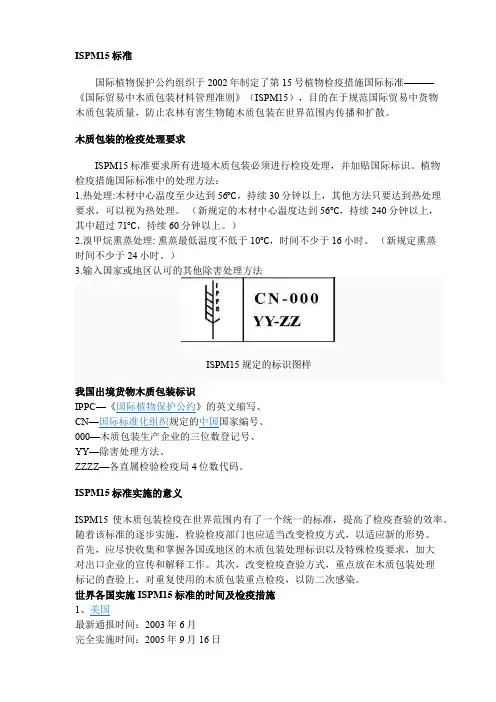
ISPM15标准国际植物保护公约组织于2002年制定了第15号植物检疫措施国际标准———《国际贸易中木质包装材料管理准则》(ISPM15),目的在于规范国际贸易中货物木质包装质量,防止农林有害生物随木质包装在世界范围内传播和扩散。
木质包装的检疫处理要求ISPM15标准要求所有进境木质包装必须进行检疫处理,并加贴国际标识。
植物检疫措施国际标准中的处理方法:1.热处理:木材中心温度至少达到56℃,持续30分钟以上,其他方法只要达到热处理要求,可以视为热处理。
(新规定的木材中心温度达到56℃,持续240分钟以上,其中超过71℃,持续60分钟以上。
)2.溴甲烷熏蒸处理: 熏蒸最低温度不低于10℃,时间不少于16小时。
(新规定熏蒸时间不少于24小时。
)3.输入国家或地区认可的其他除害处理方法ISPM15规定的标识图样我国出境货物木质包装标识IPPC—《国际植物保护公约》的英文缩写、CN—国际标准化组织规定的中国国家编号、000—木质包装生产企业的三位数登记号、YY—除害处理方法、ZZZZ—各直属检验检疫局4位数代码。
ISPM15标准实施的意义ISPM15使木质包装检疫在世界范围内有了一个统一的标准,提高了检疫查验的效率。
随着该标准的逐步实施,检验检疫部门也应适当改变检疫方式,以适应新的形势。
首先,应尽快收集和掌握各国或地区的木质包装处理标识以及特殊检疫要求,加大对出口企业的宣传和解释工作。
其次,改变检疫查验方式,重点放在木质包装处理标记的查验上,对重复使用的木质包装重点检疫,以防二次感染。
世界各国实施ISPM15标准的时间及检疫措施1、美国最新通报时间:2003年6月完全实施时间:2005年9月16日过渡期:2004年1月1日-2005年9月16日旧木质包装检疫措施:()自1998年12月27日起,输美货物木质包装须经热处理、熏蒸处理或防腐处理,并附有官方检疫机构出具的相关证书;(2)如无木质包装则由出口商出具无木质包装证明。
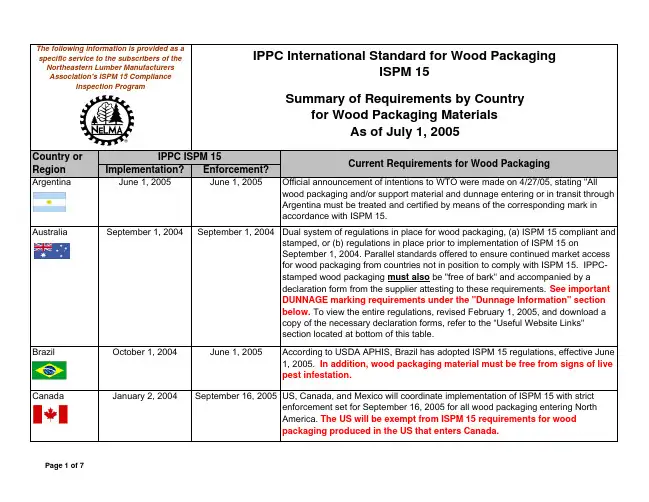
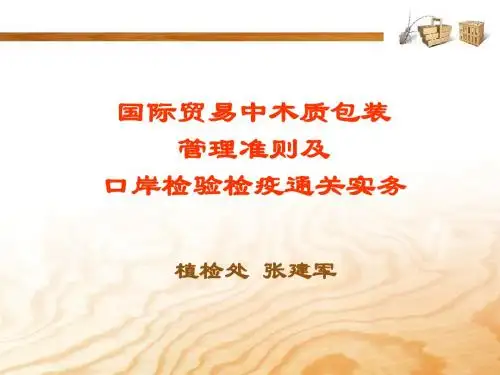
本文由lqkun518贡献doc文档可能在WAP端浏览体验不佳。
建议您优先选择TXT,或下载源文件到本机查看。
ISPM 15 系针对未经加工原木制作的木质包装材料之检疫安全制定规范,本文简介 ISPM 15 的重要内容及各国制定木质包装材料之检疫措施,并讨论对我国之影响及因应策略。
关键词:木质包装材料、国际植物检疫标准、ISPM。
壹、前言 1996年美国农业部首度证实光肩星天牛(Asian longhorned beetle, Anoplophora glabripennis)入侵纽约州,该年为了压制此虫的蔓延危害,就花费了400余万美元;1998年伊利诺伊州的芝加哥也发现此虫入侵,其后陆续在各地有发现的报导。
目前的数据显示,光肩星天牛已在纽约二处及芝加哥三处地区的森林危害,并在全美15个州27个放置进口货品的仓库中的木材包装箱中找到,其中绝大多数为自中国进口。
美国农业部估计此虫若扩散全美国,对木材、槭糖浆、苗圃、果树及观光旅游等产业会造成超过6,500亿美元的损失,因此在纽约及芝加哥积极展开扑灭计划,将受害林木砍除销毁,迄今联邦政府和州政府已支用超过8,000万美元的扑灭经费(APHIS, 2002)。
由于光肩星天牛是经由中国输美货物的实木包装材料(solid wood packing materials,简称 SWPM)入侵美国的,因此自1998年12月起,美国要求中国及香港输美的所有 SWPM 都必须在入境前按照规定的程序予以熏蒸处理或热处理,否则便不准放行(赵,2000)或必须使用其它包装材料。
此后,许多国家对 SWPM 相继采取严格的检疫措施,此案对中国与美国的贸易,甚至全世界的贸易造成极为深远的影响。
为促进农产品贸易自由化,世界贸易组织(WTO)之食品安全检验与动植物防疫检疫措施协议(Agreement on the Application of Sanitary and Phytosanitary Measures, 简称 SPS 协议)托付国际植物保护公约(International Plant Protection Convention, IPPC)组织制定各项国际植物检疫标准(International Standards for Phytosanitary Measures, ISPMs),以规范植物及其产品之国际贸易及提供各国制定其植物防疫检疫措施之参考,迄2003年4月已批准公告19 项的 ISPMs。
《国际贸易中木质包装材料管理标准》(ISPM15号)
第15号国际标准《国际贸易中木质包装材
料管理准则》
2002年3月IPPC发布了国际植物检疫措施标准第15号出版物《国际贸易中木质包装材料管理准则》(Guidelines for Regulating Wood Packing Material in International Trade),简称第15号国际标准,即为国际木质包装检疫措施标准。
木质包装是有害生物传播和扩散的重要途径,由于木质包装往往重复使用,产地难于确定,不可能通过风险分析来确定采取措施的必要性。
因此,IPPC制定了《国际贸易中木质包装材料管理准则》,建议所有国家或地区采取统一的木质包装管理措施,降低有害生物传播和扩散的风险。
标准所指的木质包装,指用于包装、铺垫、支撑、加固货物的木质材料,如木箱、木板条箱、木托盘、垫仓木料、木桶、木垫方、枕木、木衬板、木轴、木楔等。
经人工合成的材料或经加热、消毒等深度加工的包装用木质材料,如胶合板、纤维板等不在此列。
标准明确了木质包装除害处理及标识方法,建议所有国家或地区采用该标准,而不再提出进一步的要求,如出具植物检疫证书等。
标准要求输出国对木质包装除害处理过程实施监控,给予实施除害处理木质包装生产企业特定的编码。
输入国有权对采用第15号国际标准的木质包装实施检疫。
标准批准的除害处理方法,包括热处理和溴甲烷熏蒸处理。
IPPC 将根据国家植保机构提供的信息,审查修订已批准的除害处理方法,批
准其它的除害处理方法。
标准规定,标识标识必须加施于木质包装显著位置,至少应在相对的两面,标识应清晰易辨、永久且不能移动,避免使用红色或橙色。
INTERNATIONAL STANDARDS FOR PHYTOSANITARY MEASURESGuidelines for regulating wood packaging material in international trade ISPM No. 15CONTENTS ENDORSEMENT (199)INTRODUCTION SCOPE (199)REFERENCES (199)DEFINITIONS (199)OUTLINE OF REQUIREMENTS (199)REGULATORY REQUIREMENTS1. Basis for Regulating (200)2. Regulated Wood Packaging Material (200)3. Measures for Wood Packaging Material (200)3.1 Approved measures (200)3.2 Measures pending approval (201)3.3 Other measures (201)3.4 Review of measures (201)OPERATIONAL REQUIREMENTS (201)4. Dunnage (201)5. Procedures Used Prior to Export (201)5.1 Compliance checks on procedures applied prior to export (201)5.2 Transit arrangements (201)6. Procedures upon Import (201)6.1 Measures for non-compliance at point of entry (202)6.2 Disposal (202)ANNEXESI. Approved measures associated with wood packaging material (203)II. Marking for approved measures (204)III. Measures being considered for approval under this standard (205)ENDORSEMENTThis standard was endorsed by the Interim Commission on Phytosanitary Measures in March 2002. Modifications to Annex I were endorsed by the Commission on Phytosanitary Measures in April 2006.INTRODUCTIONSCOPEThis standard describes phytosanitary measures to reduce the risk of introduction and/or spread of quarantine pests associated with wood packaging material (including dunnage), made of coniferous and non-coniferous raw wood, in use in international trade.REFERENCESAgreement on the Application of Sanitary and Phytosanitary Measures, 1994. World Trade Organization, Geneva. Export certification system, 1997. ISPM No. 7, FAO, Rome.Glossary of phytosanitary terms, 2001. ISPM No. 5, FAO, Rome.Guidelines for phytosanitary certificates, 2001. ISPM No. 12, FAO, Rome.Guidelines on notification of non-compliance and emergency action, 2001. ISPM No. 13, FAO, Rome.ISO 3166-1-ALPHA-2 CODE ELEMENTS (http://www.din.de/gremien/nas/nabd/iso3166ma/codlstp1/en_listp1.html) International Plant Protection Convention, 1997. FAO, Rome.Principles of plant quarantine as related to international trade, 1995. ISPM No. 1, FAO, Rome.DEFINITIONSDefinitions of phytosanitary terms used in the present standard can be found in ISPM No. 5 (Glossary of phytosanitary terms).OUTLINE OF REQUIREMENTSWood packaging material made of unprocessed raw wood is a pathway for the introduction and spread of pests. Because the origin of wood packaging material is often difficult to determine, globally approved measures that significantly reduce the risk of pest spread are described. NPPOs are encouraged to accept wood packaging material that has been subjected to an approved measure without further requirements. Such wood packaging material includes dunnage, but excludes processed wood packaging material.Procedures to verify that an approved measure, including the application of a globally recognized mark, has been applied should be in place in both exporting and importing countries. Other measures agreed to under a bilateral arrangement are also considered in this standard. Wood packaging material that does not comply with the requirements of this standard should be disposed of in an approved manner.REGULATORY REQUIREMENTS1. Basis for RegulatingWood packaging material is frequently made of raw wood that may not have undergone sufficient processing or treatment to remove or kill pests and therefore becomes a pathway for the introduction and spread of pests. Furthermore, wood packaging material is very often re-used, recycled or re-manufactured (in that packaging received with an imported consignment may be re-used to accompany another consignment for export). The true origin of any piece of wood packaging material is difficult to determine and thus its phytosanitary status cannot be ascertained. Therefore the normal process of undertaking risk analysis to determine if measures are necessary and the strength of such measures is frequently not possible for wood packaging material because its origin and phytosanitary status may not be known. For this reason, this standard describes globally accepted measures that are approved and that may be applied to wood packaging material by all countries to practically eliminate the risk for most quarantine pests and significantly reduce the risk from a number of other pests that may be associated with that material.Countries should have technical justification for requiring the application of the approved measures as described in this standard for imported wood packaging material. Requiring phytosanitary measures beyond an approved measure as described in this standard also requires technical justification.2. Regulated Wood Packaging MaterialThese guidelines are for coniferous and non-coniferous raw wood packaging material that may serve as a pathway for plant pests posing a threat mainly to living trees. They cover wood packaging material such as pallets, dunnage, crating, packing blocks, drums, cases, load boards, pallet collars, and skids which can be present in almost any imported consignment, including consignments which would not normally be the target of phytosanitary inspection.Wood packaging made wholly of wood-based products such as plywood, particle board, oriented strand board or veneer that have been created using glue, heat and pressure or a combination thereof should be considered sufficiently processed to have eliminated the risk associated with the raw wood. It is unlikely to be infested by raw wood pests during its use and therefore should not be regulated for these pests.Wood packaging material such as veneer peeler cores1, sawdust, wood wool, and shavings, and raw wood cut into thin2 pieces may not be pathways for introduction of quarantine pests and should not be regulated unless technically justified.3. Measures for Wood Packaging Material3.1 Approved measuresAny treatment, process, or a combination of these that is significantly effective against most pests should be considered effective in mitigating pest risks associated with wood packaging material used in transport. The choice of a measure for wood packaging material is based on consideration of:- the range of pests that may be affected- the efficacy of the measure- the technical and/or commercial feasibility.Approved measures should be accepted by all NPPOs as the basis for authorizing the entry of wood packaging material without further requirements except where it is determined through interceptions and/or PRA that specific quarantine pests associated with certain types of wood packaging material from specific sources require more rigorous measures.Approved measures are specified in Annex I.Wood packaging material subjected to these approved measures should display a specified mark shown in Annex II.The use of marks addresses the operational difficulties associated with the verification of compliance with treatment for wood packaging material. A universally recognized, non-language specific mark facilitates verification during inspection at the point of export, at the point of entry or elsewhere.References for supporting documentation on approved measures are available from the IPPC Secretariat.1Veneer peeler cores are a by-product of veneer production involving high temperatures and comprising the center of a log remaining after the peeling process.2 Thin wood is considered to be 6mm thickness or less according to the Customs Harmonized Commodity Description and Coding System (the Harmonized System or HS).3.2 Measures pending approvalOther treatments or processes for wood packaging material will be approved when it can be demonstrated that they provide an appropriate level of phytosanitary protection (Annex III). The currently measures identified in Annex I continue to be under review, and new research may point, for example, to other temperature/time combinations. New measures may also reduce risk by changing the character of the wood packaging material. NPPOs should be aware that measures may be added or changed and should have sufficiently flexible import requirements for wood packaging to accommodate changes as they are approved.3.3 Other measuresNPPOs may accept any measures other than those listed in Annex I by arrangement with their trading partners, especially in cases where the measures listed in Annex I cannot be applied or verified in the exporting country. Such measures should be technically justified and respect the principles of transparency, non-discrimination and equivalence.The NPPOs of importing countries should consider other arrangements for wood packaging material associated with exports from any country (or particular source) where evidence is provided which demonstrates that the pest risk is adequately managed or absent (e.g. areas with similar phytosanitary situations or pest free areas).Certain movements of wood packaging material (e.g. tropical hardwoods associated with exports to temperate countries) may be considered by the importing NPPO not to carry a phytosanitary risk and thus can be exempted from measures. Subject to technical justification, countries may require that imported wood packaging material subjected to an approved measure be made from debarked wood and display a mark as shown in Annex II.3.4 Review of measuresThe approved measures specified in Annex I and the list of measures under consideration in Annex III should be reviewed based on new information provided to the Secretariat by NPPOs. This standard should be amended appropriately by the ICPM.OPERATIONAL REQUIREMENTSTo meet the objective of preventing the spread of pests, both exporting and importing countries should verify that the requirements of this standard have been met.4. DunnageIdeally, dunnage should also be marked in accordance with Annex II of this standard as having been subjected to an approved measure. If not, it requires special consideration and should, as a minimum, be made from bark-free wood that is free from pests and signs of live pests. Otherwise it should be refused entry or immediately disposed of in authorized manner (see section 6).5. Procedures Used Prior to Export5.1 Compliance checks on procedures applied prior to exportThe NPPO of the exporting country has responsibility for ensuring that systems for exports meet the requirements set out in this standard. It includes monitoring certification and marking systems that verify compliance, and establishing inspection procedures (see also ISPM No. 7: Export certification system), registration or accreditation and auditing of commercial companies that apply the measures, etc.5.2 Transit arrangementsWhere consignments moving in transit have exposed wood packaging material that has not met the requirements for approved measures, the NPPOs of the transit countries may require measures in addition to those of the importing country to ensure that wood packaging material does not present an unacceptable risk.6. Procedures upon ImportThe regulation of wood packaging material requires that NPPOs have policies and procedures for other aspects of their responsibilities related to wood packaging material.Since wood packaging materials are associated with almost all shipments, including those not normally the target of phytosanitary inspections, cooperation with agencies, organizations, etc. not normally involved with meeting phytosanitary export conditions or import requirements is important. For example, cooperation with Customsorganizations should be reviewed to ensure effectiveness in detecting potential non-compliance of wood packaging material. Cooperation with the producers of wood packaging material also needs to be developed.6.1 Measures for non-compliance at point of entryWhere wood packaging material does not carry the required mark, action may be taken unless other bilateral arrangements are in place. This action may take the form of treatment, disposal or refused entry. The NPPO of the exporting country may be notified (see ISPM No. 13: Guidelines on notification of non-compliance and emergency action). Where the wood packaging material does carry the required mark, and evidence of live pests is found, action can be taken. These actions may take the form of treatment, disposal or refused entry. The NPPO of the exporting country should be notified in cases where live pests are found, and may be notified in other cases (see ISPM No. 13: Guidelines on notification of non-compliance and emergency action).6.2 DisposalDisposal of wood packaging material is a risk management option that may be used by the NPPO of the importing country upon arrival of the wood packaging material where treatment is not available or desirable. The following methods are recommended for the disposal of wood packaging material where this is required. Wood packaging material that requires emergency action should be appropriately safeguarded prior to treatment or disposal to prevent escape of any pest between the time of the detection of the pest posing the threat and the time of treatment or disposal. IncinerationComplete burningBurialDeep burial in sites approved by appropriate authorities. (Note: not a suitable disposal option for wood infested with termites). The depth of the burial may depend on climatic conditions and the pest, but is recommended to be at least 1 metre. The material should be covered immediately after burial and should remain buried.ProcessingChipping and further processing in a manner approved by the NPPO of the importing country for the elimination of pests of concern (e.g. manufacture of oriented strand board).Other methodsProcedures endorsed by the NPPO as effective for the pests of concern.The methods should be applied with the least possible delay.ANNEX I (modified in 2006)APPROVED MEASURES ASSOCIATED WITH WOOD PACKAGING MATERIALHeat treatment (HT)Wood packaging material should be heated in accordance with a specific time-temperature schedule that achieves a minimum wood core temperature of 56°C for a minimum of 30 minutes3.Kiln-drying (KD), chemical pressure impregnation (CPI), or other treatments may be considered HT treatments to the extent that these meet the HT specifications. For example, CPI may meet the HT specification through the use of steam, hot water, or dry heat.Heat treatment is indicated by the mark HT. (see Annex II)Methyl bromide (MB) fumigation for wood packaging material (modified in 20064)The wood packaging material should be fumigated with methyl bromide. The treatment is indicated by the mark MB. The minimum standard for methyl bromide fumigation treatment for wood packaging material is as follows:Temperature DosageMinimum concentration (g/m3) at:(g/m3) 2hrs. 4hrs. 12hrs. 24hrs.21°C or above 48 36 31 28 2416°C or above 56 42 36 32 2810°C or above 64 48 42 36 32The minimum temperature should not be less than 10°C and the minimum exposure time should be 24 hours. Monitoring of concentrations should be carried out at a minimum at 2, 4 and 24 hrs.List of most significant pests targeted by HT and MBMembers of the following pest groups associated with wood packaging material are practically eliminated by HT and MB treatment in accordance with the specifications listed above:Pest groupInsectsAnobiidaeBostrichidaeBuprestidaeCerambycidaeCurculionidaeIsopteraLyctidae (with some exceptions for HT)OedemeridaeScolytidaeSiricidaeNematodesBursaphelenchus xylophilus3 A minimum core temperature of 56° C for a minimum of 30 min. is chosen in consideration of the wide range of pests for which this combination is documented to be lethal and a commercially feasible treatment. Although it is recognized that some pests are known to have a higher thermal tolerance, quarantine pests in this category are managed by NPPOs on a case by case basis.4 When a revised schedule is adopted for treatment of wood packaging, material treated under the previous treatment schedule does not need to be retreated, remarked or recertified.ANNEX IIMARKING FOR APPROVED MEASURESThe mark shown below is to certify that the wood packaging material that bears the mark has been subjected to anThe mark should at minimum include the:- symbol- ISO two letter country code followed by a unique number assigned by the NPPO to the producer of the wood packaging material, who is responsible for ensuring appropriate wood is used and properly marked- IPPC abbreviation according to Annex I for the approved measure used (e.g. HT, MB).NPPOs, producers or suppliers may at their discretion add control numbers or other information used for identifying specific lots. Where debarking is required the letters DB should be added to the abbreviation of the approved measure. Other information may also be included provided it is not confusing, misleading, or deceptive.Markings should be:- according to the model shown here- legible- permanent and not transferable- placed in a visible location, preferably on at least two opposite sides of the article being certified.The use of red or orange should be avoided since these colors are used in the labeling of dangerous goods. Recycled, remanufactured or repaired wood packaging material should be re-certified and re-marked. All components of such material should have been treated.Shippers should be encouraged to use appropriately marked wood for dunnage.Guidelines for regulating wood packaging material in international trade ISPM No. 15ANNEX III MEASURES BEING CONSIDERED FOR APPROVAL UNDER THIS STANDARD Treatments5 being considered and which may be approved when appropriate data becomes available, include but are not limited to:FumigationPhosphineSulfuryl fluorideCarbonyl sulphideCPIHigh-pressure/vacuum processDouble vacuum processHot and cold open tank processSap displacement methodIrradiationGamma radiationX-raysMicrowavesInfra redElectron beam treatmentControlled atmosphere5 Certain treatments such as phosphine fumigation and some CPI treatments are generally believed to be very effective but at present lack experimental data concerning efficacy which would allow them to be approved measures. This present lack of data is specifically in relation to the elimination of raw wood pests present at the time of application of the treatment.International Standards for Phytosanitary Measures No. 1 to 29 (2007 edition) 205。
ISPM15标准国际植物保护公约组织于2002年制定了第15号植物检疫措施国际标准———《国际贸易中木质包装材料管理准则》(ISPM15),目的在于规范国际贸易中货物木质包装质量,防止农林有害生物随木质包装在世界范围内传播和扩散。
木质包装的检疫处理要求ISPM15标准要求所有进境木质包装必须进行检疫处理,并加贴国际标识。
植物检疫措施国际标准中的处理方法:1.热处理:木材中心温度至少达到56℃,持续30分钟以上,其他方法只要达到热处理要求,可以视为热处理。
(新规定的木材中心温度达到56℃,持续240分钟以上,其中超过71℃,持续60分钟以上。
)2.溴甲烷熏蒸处理: 熏蒸最低温度不低于10℃,时间不少于16小时。
(新规定熏蒸时间不少于24小时。
)3.输入国家或地区认可的其他除害处理方法ISPM15规定的标识图样我国出境货物木质包装标识IPPC—《国际植物保护公约》的英文缩写、CN—国际标准化组织规定的中国国家编号、000—木质包装生产企业的三位数登记号、YY—除害处理方法、ZZZZ—各直属检验检疫局4位数代码。
ISPM15标准实施的意义ISPM15使木质包装检疫在世界范围内有了一个统一的标准,提高了检疫查验的效率。
随着该标准的逐步实施,检验检疫部门也应适当改变检疫方式,以适应新的形势。
首先,应尽快收集和掌握各国或地区的木质包装处理标识以及特殊检疫要求,加大对出口企业的宣传和解释工作。
其次,改变检疫查验方式,重点放在木质包装处理标记的查验上,对重复使用的木质包装重点检疫,以防二次感染。
世界各国实施ISPM15标准的时间及检疫措施1、美国最新通报时间:2003年6月完全实施时间:2005年9月16日过渡期:2004年1月1日-2005年9月16日旧木质包装检疫措施:()自1998年12月27日起,输美货物木质包装须经热处理、熏蒸处理或防腐处理,并附有官方检疫机构出具的相关证书;(2)如无木质包装则由出口商出具无木质包装证明。
新木质包装检疫措施:(1)所有的进境木质包装均按ISPM#15国际标准实施除害处理并加施标识;(2)不符合ISPM#15号国际标识的将立即要求退运。
过渡期措施:从2004年1月起将向出口国NPPO通报木质包装未经适当处理和标识的情况,但在其新的法规完成前不采取其它措施。
2、加拿大最新通报时间:2004年06月21日完全实施时间:2005年4月1日过渡期:2004年6月1日-2005年4月1日旧木质包装检疫措施:(1)自1999年1月4日起,输加货物木质包装须经除害处理,并附有官方检疫机构出具的相关证书;(2)不带树皮、活虫及活虫痕迹;(3)如无木质包装,则须附有出口商出具的无木质包装证明。
新木质包装检疫措施:(1)所有的进境木质包装(除美国)均按ISPM#15号国际标准实施除害处理;(2)标识可以采用国际标准的要求,也可自行制定,但必须事先通报CIFA.(3)不符合ISPM#15号国际标准的将实施退运处理。
过渡期措施:(1)原指令中规定2004年6月1日前,仍可由出口国NPPO出具官方检疫证书;(2)现规定从2004年1月起将向出口国官方植物保护机构通报木质包装未经适当处理和标识的情况,但对木质包装的检疫要求仍按原指令执行。
3、墨西哥最新通报时间:2003年12月10日初步实施时间:第五条于2005年7月1日生效完全实施时间:其他待定旧木质包装检疫措施:对我国输墨西哥木质包装无特殊检疫要求新木质包装检疫措施:采用ISPM15#,检疫措施类似于美国过渡期措施:注:未见正式法规文本,仅见其官方网站信息。
4、北美植保组织加拿大、美国、墨西哥、三个北美植保组织成员将协调分阶段逐步实施ISPM NO15标准,现美国和加拿大已公布实施时间,预计墨西哥将于2005年中期正式实施。
在第一阶段将向出口国官方植物保护机构通报木质包装不符合ISPM NO15号的情况。
5、澳大利亚最新通报时间:2004年06月21日初步实施时间:2004年7月1日完全实施时间:2004年9月1日过渡期:2004年7月1日-2004年9月1日旧木质包装检疫措施:所有木材和木制品(含经深加工的木制品,如胶合板、纤维板等)在输入澳大利亚前,均需在出口国进行熏蒸除害处理,并由官方检疫机构出具植物检疫证书或熏蒸/消毒证书。
新木质包装检疫措施:(1)按国际标准处理并标识,同时不带树皮,且溴甲烷熏蒸处理应符合澳大利亚检疫处理规程要求;(2)不得带有树皮、虫孔及活的有害生物为害迹象。
取消处理到装船不超过21天的期限;(3)无IPPC标识的须出具除害处理证书或由AQIS实施除害处理、销毁。
6、新西兰最新通报时间:2003年04月29日初步实施时间:2003年4月16日旧木质包装检疫措施:所有木材和木制品(含经深加工的木制品,如胶合板、纤维板等)在输入新西兰前,均需在出口国进行熏蒸除害处理,并由官方检疫机构出具植物检疫证书或熏蒸/消毒证书。
新木质包装检疫措施:(1)质包装不带活虫、树皮、虫孔及土壤、树枝等附着物;(2)采用ISPM15#标准的,按规定处理并加施标识;(3)不采用ISPM15#标准的,可按新西兰提出的熏蒸、化学加压等方法处理,并出具相关证书。
7、欧盟最新通报时间:2003年11月10日初步实施时间:2004年7月1日完全实施时间:2005 年3月1日过渡期:部分实施过渡期至2007年6月30日旧木质包装检疫措施:(1)来自中国的木质包装不得带有树皮,直径大于3毫米的虫孔;或者木材含水量低于20%;(2)来自松线虫疫区的针叶树木质包装须进行除害处理并施加标识,并出具官方检疫机构植物检疫证书;(3)来自非松树线虫疫区的针叶树木质包装,由官方检疫机构实施检疫并出具检疫证书,证明木质包装来自非疫区。
新木质包装检疫措施:(1)有去皮原木制成;或者根据ISPM15#标准实施除害处理并加施标识;(2)2004年6月30日前生产、修理、循环使用,但标识中不含有FAO专用标识的木质包装只能重复使用至2007年6月30日;(3)对于撑木和木械要求不带树皮虫孔并进行除害处理,施加标识,过渡期至2007年6月30日。
8、英国初步实施时间:2004年7月1日旧木质包装检疫措施:同欧盟新木质包装检疫措施:总体要求与欧盟一致,但有些细节要求不一致,如标识中各要素的位置可以由木质包装生产企业调节,特别是为考虑到标识的清晰度,IPPC的标志不一定要加施在每个单独的木箱上。
9、韩国最新通报时间:2003年07月11日初步实施时间:2005年6月1日完全实施时间:2005年6月1日新木质包装检疫措施:(1)采用ISPM15#制定了本国的木质包装检疫措施;(2)除害处理标准和标识体系与ISPM15#要求相同;(3)韩国将我国划为松材线虫疫区,输韩针叶木质包装全部要求热处理。
10、阿根廷旧木质包装检疫措施:(1)不得带有活虫,树皮和活虫活动的痕迹;(2)出口商须有相关贸易单证中声明符合上述要求;(3)对不符合上述要求的,海关将扣留直至进口商按SENASA要求进行处理。
新木质包装检疫措施: 尚未采用 ISPM15#标准。
11、巴西最新通报时间:2004年11月4日完全实施时间:待定旧木质包装检疫措施:须经热处理、熏蒸处理或巴方认可的其它处理方法,并提供官方植物检疫证书。
新木质包装检疫措施:(1)采用ISPM15#标准,要求进境木质包装按照标准实施处理;(2)不得带有活的有害生物感染痕迹。
12、瑞士最新通报时间:2004年2月5日初步实施时间:2004年7月1日新木质包装检疫措施:按木质包装检疫国际标准执行,具体文本未见。
13、日本新木质包装检疫措施:对进口货物木质包装材料导致有害生物侵入日本的危害程度进行评估,当认为有害生物随进口货物的木质包装侵入日本的风险较高时,日本也将根据国际标准实施限制措施,并且该方针明确后,还将向WTO通报。
14、南非最新通报时间:2004年04月27日初步实施时间:2004年11月1日完全实施时间:2005年1月1日过渡期:2004年11月1日-2005年1月1日新木质包装检疫措施:按木质包装检疫国际标准执行,具体文本未见。
15、菲律宾最新通报时间:2004年06月03日初步实施时间:2004年6月1日完全实施时间:2005年1月1日部分执行新木质包装检疫措施:按木质包装检疫国际标准执行,具体文本未见。
16、印度初步实施时间:2004年11月1日新木质包装检疫措施:按照国际标准对输印木质包装实施处理和加施标识。
17、斐济初步实施时间:2004年1月1日18、斯里兰卡初步实施时间:2004年3月1日19、智利最新通报时间:2004年8月27日完全实施时间:2005年6月1日新木质包装检疫措施:(1)采用ISPM15#制定了本国的木质包装检疫措施;(2)除害处理标准和标识体系与ISPM15#要求相同。
20、哥斯达黎加最新通报时间:2004年8月20日初步实施时间:2005年1月1日完全实施时间:2005年9月16日新木质包装检疫措施:已经采用ISPM15#21、哥伦比亚最新通报时间:2004年7月9日初步实施时间:2005年1月1日完全实施时间:2005年9月1日新木质包装检疫措施:按照ISPM15#要求,参与木质包装生产、销售、除害处理的企业需取得ICA的认可。
22、土耳其完全实施时间:2005年1月1日新木质包装检疫措施:要求进境木质包装不带树皮,并按照ISPM15#标准要求实施除害处理并加施标识。
23、尼日利亚最新通报时间:2004年9月30日初步实施时间:2004年9月30日参考资料。